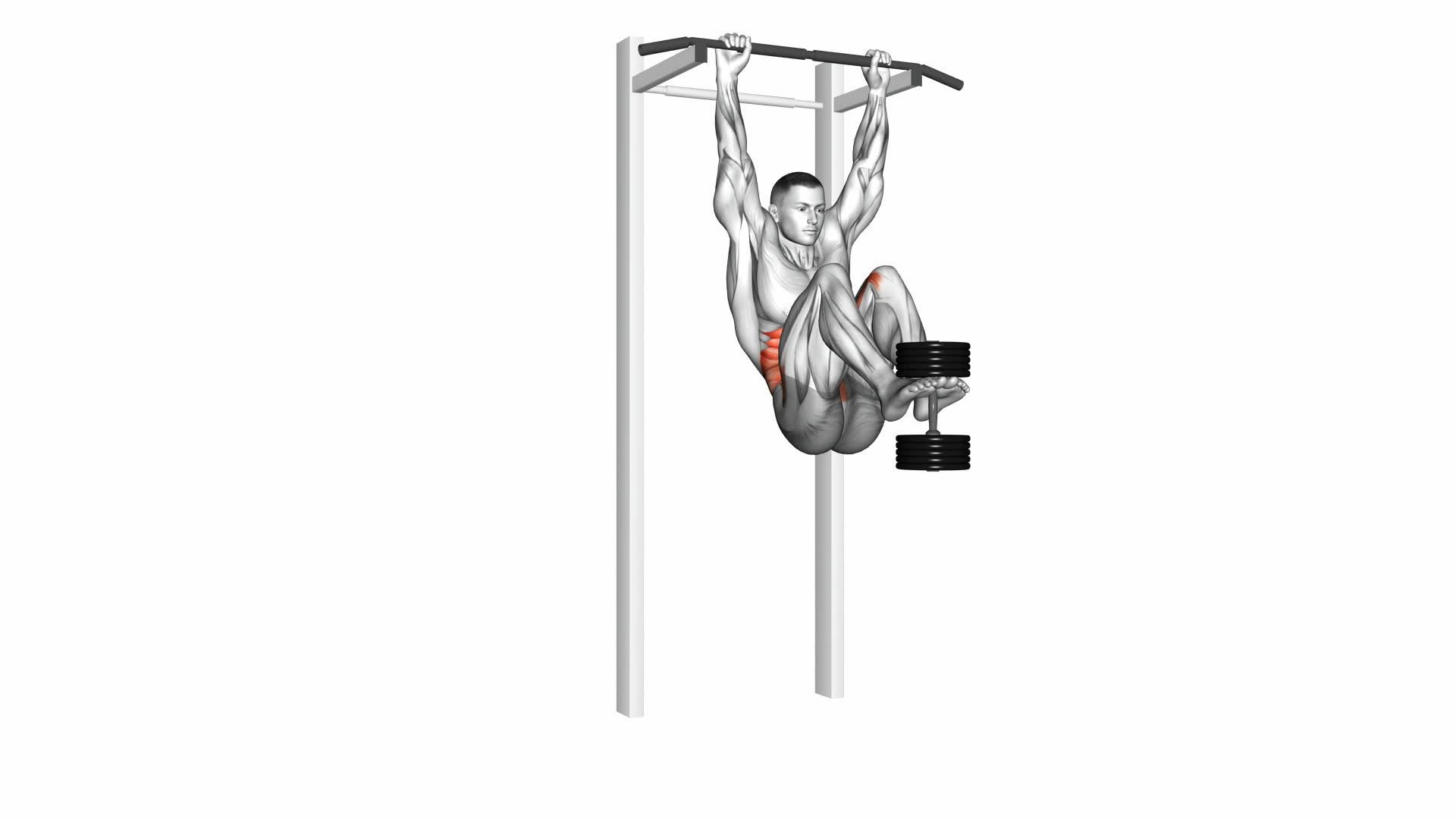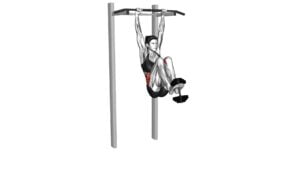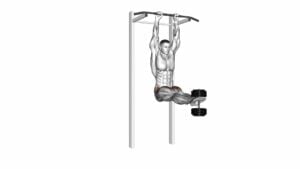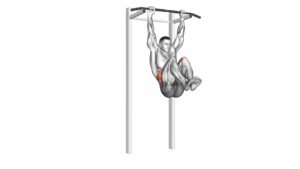Weighted Hanging Leg Hip Raise – Video Exercise Guide & Tips

Get ready to strengthen your core and lower body with the weighted hanging leg hip raise. In this exercise, you'll be hanging from a bar and raising your legs while engaging your hips.
Watch This Exercise Video
This challenging move targets your abs, hip flexors, and glutes. Don't worry if you're new to this exercise, we've got you covered with a video exercise guide and helpful tips to ensure proper form and technique.
Let's get started!
Key Takeaways
- Weighted hanging leg hip raise strengthens core and hip muscles.
- Proper form and technique are crucial for maximizing muscle activation and reducing the risk of injury.
- Gradually increasing weight challenges as strength improves is recommended.
- Advanced variations and modifications can be used to further target specific muscles and increase overall strength and stability.
Benefits of Weighted Hanging Leg Hip Raise
You can experience significant strength gains in your core and hip muscles by incorporating weighted hanging leg hip raises into your workout routine. This exercise specifically targets the muscles in your core and hips, leading to improved muscle activation and increased core strength.
When performing weighted hanging leg hip raises, the weight adds an extra challenge to the movement, forcing your core and hip muscles to work harder to lift your legs. This increased resistance results in greater muscle activation, meaning that your muscles are working harder and becoming stronger with each repetition.
Not only does this exercise target your core muscles, but it also engages your hip muscles. The movement requires you to stabilize your hips as you raise your legs, which helps to strengthen the muscles in that area. Strong hip muscles are crucial for maintaining proper posture, balance, and stability in various activities and sports.
To ensure that you get the most out of this exercise, it's important to maintain proper form and technique. By following the correct form, you can maximize the activation of your core and hip muscles, leading to optimal strength gains.
Proper Form and Technique
Maintaining proper form and technique is essential for maximizing the activation of your core and hip muscles during weighted hanging leg hip raises. To ensure you're performing this exercise correctly, follow these tips:
- Proper alignment:
- Hang from a pull-up bar with your arms fully extended and your shoulders relaxed.
- Engage your core muscles and maintain a neutral spine throughout the movement.
- Keep your legs straight and together, with your toes pointed.
- Breathing techniques:
- Inhale as you raise your legs, focusing on lengthening your spine and maintaining stability.
- Exhale as you lower your legs back down, contracting your abdominal muscles.
- Avoid holding your breath during the exercise, as it can increase tension and decrease stability.
By maintaining proper alignment, you'll target the intended muscles effectively and reduce the risk of injury.
Additionally, practicing proper breathing techniques will help you engage your core muscles and enhance your overall performance.
Remember to start with a weight that challenges you but still allows for proper form. As you become more comfortable and stronger, you can gradually increase the weight to continue progressing in your training.
Recommended Weight Plate Size
To determine the appropriate weight plate size for weighted hanging leg hip raises, consider your current strength level and training goals. Adding weight to this exercise can increase the challenge and help you build more strength in your core and hip muscles. Effective weight plate exercises can provide an extra stimulus to your muscles and enhance your overall workout. When choosing the right weight for your fitness level, it's important to start with a weight that challenges you but still allows you to maintain proper form and technique. Gradually increase the weight as your strength improves.
If you're a beginner, it's recommended to start with a lighter weight plate, such as 2.5 or 5 pounds. As you become more comfortable and stronger, you can progress to heavier plates, such as 10 or 15 pounds. Intermediate or advanced lifters may opt for even heavier plates, such as 25 or 45 pounds, depending on their individual strength levels.
It's crucial to listen to your body and avoid using a weight that's too heavy for you, as it can compromise your form and increase the risk of injury. Remember, the goal is to challenge yourself without sacrificing proper technique.
Now that you know how to choose the right weight plate size, let's move on to discussing common mistakes to avoid during weighted hanging leg hip raises.
Common Mistakes to Avoid
To ensure proper form and maximize the effectiveness of your weighted hanging leg hip raises, it's important to be mindful of common mistakes that can hinder your progress. Here are some common mistakes to avoid:
- Swinging: One common mistake is using momentum to swing your legs instead of relying on your core muscles. This not only reduces the effectiveness of the exercise but also puts strain on your lower back.
- Lack of proper alignment: It's crucial to maintain proper alignment throughout the exercise. Avoid arching your back or allowing your legs to drift away from your body. Keep your core engaged and your legs straight.
- Not using enough weight: While it's important to start with a weight that challenges you without compromising form, using too light of a weight can limit the benefits of the exercise. Gradually increase the weight as you get stronger to continue making progress.
By being aware of these common mistakes and focusing on proper alignment, you can ensure that you're getting the most out of your weighted hanging leg hip raises.
Remember to start with a weight that's appropriate for your fitness level and gradually increase the difficulty as you become more comfortable with the exercise.
Advanced Variations and Modifications
Once you have mastered the basic weighted hanging leg hip raise, you can take your workout to the next level by incorporating advanced variations and modifications. These advanced progressions will challenge your core and hip flexor muscles even further, helping you build strength and stability.
One advanced variation is the weighted hanging leg hip raise with a twist. To perform this exercise, hold a dumbbell or kettlebell between your feet while raising your legs. As you raise your legs, twist your hips to one side, then return to the starting position and twist to the other side. This movement engages your obliques and adds an extra level of difficulty to the exercise.
Another advanced modification is the weighted hanging leg hip raise with a knee tuck. Instead of raising your legs straight up, bring your knees towards your chest as you lift. This variation targets your lower abs and hip flexors more intensely.
If you're looking for alternative equipment options, you can use ankle weights or resistance bands to add extra resistance to the exercise. Simply attach the ankle weights or bands to your ankles and perform the weighted hanging leg hip raise as usual. This will increase the challenge and help you continue making progress in your workouts. Remember to choose a resistance level that's challenging but still allows you to maintain proper form throughout the exercise.
Incorporating these advanced variations and modifications into your weighted hanging leg hip raise routine will help you continue challenging your muscles and progressing in your fitness journey.
Frequently Asked Questions
How Many Calories Does a Weighted Hanging Leg Hip Raise Burn?
When you perform a weighted hanging leg hip raise, you can expect to burn calories and target multiple muscle groups. This exercise primarily works your abs, hip flexors, and lower back muscles.
The exact number of calories burned during this exercise varies depending on factors such as your weight, intensity, and duration of the workout. However, incorporating weighted resistance can increase the intensity and potentially help you burn more calories compared to the unweighted version of this exercise.
Can Anyone Do a Weighted Hanging Leg Hip Raise, or Are There Certain Fitness Levels Required?
Anyone can do a weighted hanging leg hip raise, but there are certain fitness levels required to perform this exercise effectively.
It's important to start with bodyweight variations and progress to using weights gradually.
Beginners can modify the exercise by using a resistance band or performing the movement on a Roman chair.
The benefits of weighted hanging leg hip raises for core strength include improved stability, increased abdominal activation, and enhanced overall athleticism.
How Often Should I Include Weighted Hanging Leg Hip Raises in My Workout Routine?
To maximize the benefits of weighted hanging leg hip raises, you need to know how often to do them. Including this exercise in your routine can be highly effective. By targeting your abs, lower back, and hip flexors, it helps strengthen your core and improves stability.
To get the best results, aim to do weighted hanging leg hip raises two to three times a week. Remember to start with a weight that challenges you but still allows for proper form.
Are There Any Alternative Exercises That Target the Same Muscle Groups as the Weighted Hanging Leg Hip Raise?
If you're looking for alternative exercises that target the same muscle groups as the weighted hanging leg hip raise, there are a few options you can try.
One option is the hanging knee raise, which focuses on the lower abs and hip flexors.
Another option is the cable crunch, which targets the upper abs.
Additionally, you can also try the Russian twist, which engages the obliques.
These exercises can be effective alternatives to incorporate into your workout routine.
Is It Normal to Experience Lower Back Pain During or After Performing Weighted Hanging Leg Hip Raises?
Experiencing lower back pain during or after weighted hanging leg hip raises isn't uncommon. It can be caused by factors such as poor form, weak core muscles, or excessive weight.
To prevent lower back pain, ensure proper technique by engaging your core, maintaining a neutral spine, and using a weight that challenges you without straining your back. Strengthening your core muscles through exercises like planks and deadlifts can also help prevent lower back pain.
Conclusion
In conclusion, the weighted hanging leg hip raise is a highly effective exercise for targeting the abdominal and hip muscles. By adding weight plates, you can challenge yourself further and increase the intensity of the workout.
It's important to maintain proper form and technique to maximize the benefits and avoid any injuries. Avoid common mistakes such as swinging or using momentum to lift your legs.
For advanced variations, you can try different modifications to keep your workouts challenging and engaging.

Author
Years ago, the spark of my life’s passion ignited in my mind the moment I stepped into the local gym for the first time. The inaugural bead of perspiration, the initial endeavor, the very first surge of endorphins, and a sense of pride that washed over me post-workout marked the beginning of my deep-seated interest in strength sports, fitness, and sports nutrition. This very curiosity blossomed rapidly into a profound fascination, propelling me to earn a Master’s degree in Physical Education from the Academy of Physical Education in Krakow, followed by a Sports Manager diploma from the Jagiellonian University. My journey of growth led me to gain more specialized qualifications, such as being a certified personal trainer with a focus on sports dietetics, a lifeguard, and an instructor for wellness and corrective gymnastics. Theoretical knowledge paired seamlessly with practical experience, reinforcing my belief that the transformation of individuals under my guidance was also a reflection of my personal growth. This belief holds true even today. Each day, I strive to push the boundaries and explore new realms. These realms gently elevate me to greater heights. The unique combination of passion for my field and the continuous quest for growth fuels my drive to break new ground.



